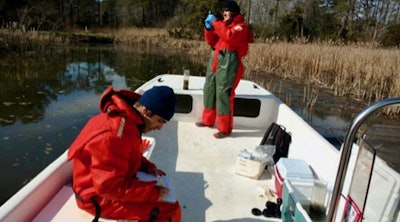
Wastewater from poultry processing plants may have previously unknown impacts on the environment, according to new research from the Virginia Institute of Marine Science.
A study of two comparable tidal streams — one downstream of a poultry processing plant — suggests that something in the plant’s discharge prevents naturally-occurring microbes from removing excess nitrate from the waterways.
While the plant was known to discharge high levels of nitrate into the creek, microscopic organisms in the stream’s sediment should have mitigated at least some of the pollution through a process called denitrification, according to Bongkeun Song, an associate professor and microbial ecologist at the College of William and Mary’s Virginia Institute of Marine Science.
But in practice, microbial activity in the creek downstream of the plant was significantly lower than the unaffected stream. When water from the water treatment plant was mixed with water and sediment from the unaffected stream in the lab, the microbes showed a similar reduction in denitrification. As a result, the plant’s discharge caused even more nutrient loading — and potential for algal blooms — than convention would suggest.
The accelerated nutrient loading could also have an impact on downstream aquaculture, which in the area mostly consists of clam and oyster operations, Song said.
Song said the discovery stemmed from a bit of a coincidence. While Song studies microbial systems in soils, his then-graduate student, Miguel Semedo, was pursuing work in marine science. It was his idea, Song said, to transfer Song’s work on the impact of farming on soils to waterways by evaluating discharge from the poultry processing plant.
It’s not clear what caused the unexpected result, Song said, but he suspects something in the plant’s discharge — antibiotics, perhaps — could be interfering with or changing the stream’s natural microscopic communities. Existing research suggests animal waste can carry antibiotics into the environment, but Song said most water quality research has focused on municipal water treatment. That has made it difficult to tease apart what about the poultry processing plant’s wastewater treatment systems could contributing to lower rates of denitrification.
“It’s very hard to determine what the component is,” he said, “but one idea we came up with is maybe antibiotics. But it might be that they are adding some kind of chemical?…. We know that just having the water mixed with healthy sediment dropped the activity, which means there is something in the water.”
He said additional research, ideally with input from industry stakeholders, would be necessary to determine what about the plant’s operation caused its outsized environmental impact. Another student is also investigating whether a similar phenomenon exists downstream of poultry houses, Song said.
“I don’t know what the solution is, how we get clean meat for the future,” he said, referencing a consumer trend of increased poultry consumption to avoid the environmental and health impacts associated with red meat. There is a push for “creating synthetic meat,” he said. “But do I want to buy that synthetic meat? I don’t know yet.”

















